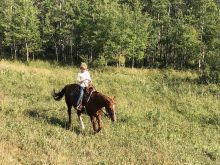For the beef handlers at Walter Farms in central Alberta it was actually a good sign — a neighbour called one day to alert them to the fact the cows were in a field of canola or corn or some type of good-looking cash crop.
While the neighbour’s concern was appreciated, the cowmen weren’t worried. The cattle were supposed to be there, and the crop was actually a 50-acre field of a new annual forage blend that included grass, legume and brassica forage varieties. People we noticing and wondering what that crop was.
Read Also

Harvest wraps up and fall work begins
At the Eppich famly ranch in western Saskatchewan, the fall harvest was successful with few breakdowns, cows and calves have been sorted and a new tractor has arrived
“It certainly doesn’t look like your average pasture,” says Ernie Lange, who is one of five partners operating the mixed crop and livestock operation near Camrose, southeast of Edmonton. These were yearling cattle and they just about disappeared in the tall, highly productive forage stand being tested on the farm.
The annual forage blend seeded by Walter Farms in 2015 and supplied by Alberta-based Union Forage, might be the key to help the beef producers pasture more cattle at home. The farm runs an 800 head Angus-cross cow-calf herd, they background their own calves, and supply yearlings to a finishing feedlot for a specialized natural beef market. The farm crops about 5,300 acres, and has another 300 acres of hay land, but pasture is spread over several Alberta locations. For easier management and better access to cattle to supply their marketing program, it would be better to pasture more cattle at home.
One option was to increase the productivity of the farm’s pasture land, and this new forage blend may be the solution.
Co-operative venture
The long-established Walter Farms and W-over-Diamond Ranches has been operating as a co-operative for the past 16 years. The five partners involved include Chris Walter and his father Sam Walter, brothers, Ed and Ernie Lange and neighbour Ralph Buhler. The co-operative shares ownership of equipment and inventory including the cattle, while each farmer owns their own land.
“We were all either smaller operators or in a position where we needed some help on our farms,” says Ed Lange. “We had always helped each other a bit with farm work, but decided to make it a more formal arrangement.” What really got the ball rolling was a plan by Ed to start a custom feedlot. The others joined in the project. They ran the feedlot jointly for 10 years, which also gave them the opportunity to expand the cow herd.

As the Angus-based beef herd grew, they also got involved in a specialty beef opportunity. Walter Farms initially was a supplier of natural, hormone- and antibiotic-free beef to the Heritage Angus Beef program, and that program is now one of the brand name products handled by the Ontario-based One Earth Farms.
The cow herd begins calving on grass in late April, remains at home until mid-June and then is distributed to various parcels of deeded and rented pasture until returning home in early November. Calves go into a backgrounding program on the farm after weaning while cows are put into a winter corn grazing program that carries the herd through until calving.
The calves are backgrounded over winter and then pastured the following year to about 850 pounds, before heading to a nearby finishing feedlot at nearby Pine Haven Colony.
“It depends on the year and cash flow needs,” says Ed Lange. “Some of the bigger calves may be sold in June, but the rest will be on pasture until they reach 850 pounds.”
With home pasture limited, Walter Farms looked for some options. It was actually the manager at Pine Haven Colony who pointed them towards forage blends marketed by Union Forage. Graeme Finn, a principle of Union Forage and technical representative in Alberta and Saskatchewan ,says the company offers some unique, yet highly productive forages, which not only put pounds on beef, but also help improve the soil.
That combination appealed to the Walter Farms group. They were familiar with a program used by Gabe Brown, a U.S. beef producer, who has talked widely in Canada and the U.S. about the benefits of growing a forage blend with as many as 20 different crops. They didn’t want to jump to that extent but were interested in trying a blend.
Trial project for 2015
Working with Finn, they developed a trial program in 2015. They took a 150-acre block of farmland — 50 acres were dedicated to their standard grass pasture and left as a check, another 50 acres were broadcast seeded and harrowed to a blend that included forage brassica, Italian ryegrass and oats, while a third 50-acre parcel was seeded with a drill to what Union Forage calls the “Peace Diverse Mix” of annual forages.
Although it was customized a bit for Walters Farm, the blend included four types of forage brassica, forage sorghum, forage millet, Italian ryegrass, 4010 peas, crimson clover, hairy vetch and a few oats and wheat. The hairy vetch and clover are annual legumes, the sorghum and millet are considered warm season forages, while the Italian rye is a cool season grass.
The forage brassicas are different creatures — Winfred is a cross between kale and turnip, Hunter is a cross between turnip and Asiatic leaf vegetables, Corinne is an Ethiopian cabbage, and Graza is a fodder radish. All grow well in most of Western Canada.
The broadcast forage mix was seeded May 15, while the drill seeded block was seeded in late May. The Walter Farms group didn’t know how these blends would produce. They added some oats and wheat to the blends just for insurance. They hoped the 150 acres would support 150 yearlings for the summer.
Cattle were turned into the standard grass paddock June 25, then later moved to the broadcast seeded block (it was divided in half) and finally moved into the drill-seeded block with the Peace forage mix (it was divided into five paddocks with portable fencing).
“With dry conditions, (about half the normal rainfall) it was actually a poorer growing season,” says Ed. “The broadcast seeded area got off to a slow start. It actually became quite weedy so at one point we had to silage part of it just to control weeds.”
And then it grew
But with a bit of rain in July the pastures really took off. While the broadcast-seeded blend performed well, the Peace-drilled seeded blend really shone. The cattle moved through those five Peace blend pastures (being moved every few days) three times during the summer and early fall, the farmers also cut about 10 tons of silage off part of the block during the late summer, and into October it was still growing.
“We actually could have run quite a few more yearlings but we didn’t know what to expect,” says Ed. “We will increase cattle numbers next year. If we had just been using our standard grass pastures there is no way a quarter section would have supported 150 head for the summer. We probably would have needed three-quarters or even a section, so the forages greatly increased carrying capacity.”
Ed says the Peace forage blend isn’t a cheap to establish, but it did greatly increase carrying capacity, put pounds on the yearlings, and also saved on the cost of trucking cattle to pasture. He estimates it cost about $75 per acre for the seeding. That included $28 per acre for the seed, $22 per acre for seeding costs with the drill, about $10 per acre for a preseeding glyphosate treatment and another $15 per acre to vertical till the field before seeding.
Walter Farms is planning to grow about 100 acres of the Peace forage blend in 2016 and may also consider seeding some for swath grazing for cattle at weaning. A couple points they will be monitoring include how to control weeds in the forage blend — with such a diverse blend chemical weed control isn’t an option. And they also want to monitor soil compaction to see if that becomes a concern.
“At one time over the years of past management the soils on this farm had some of the lowest organic matter content of any in the county,” says Lange. “But over the years as we apply conservation farming practices and keep all the manure from the cattle on the land we are now getting to where we have some of the highest organic matter content. And if you have productive soil, your crops will be productive too.”
















